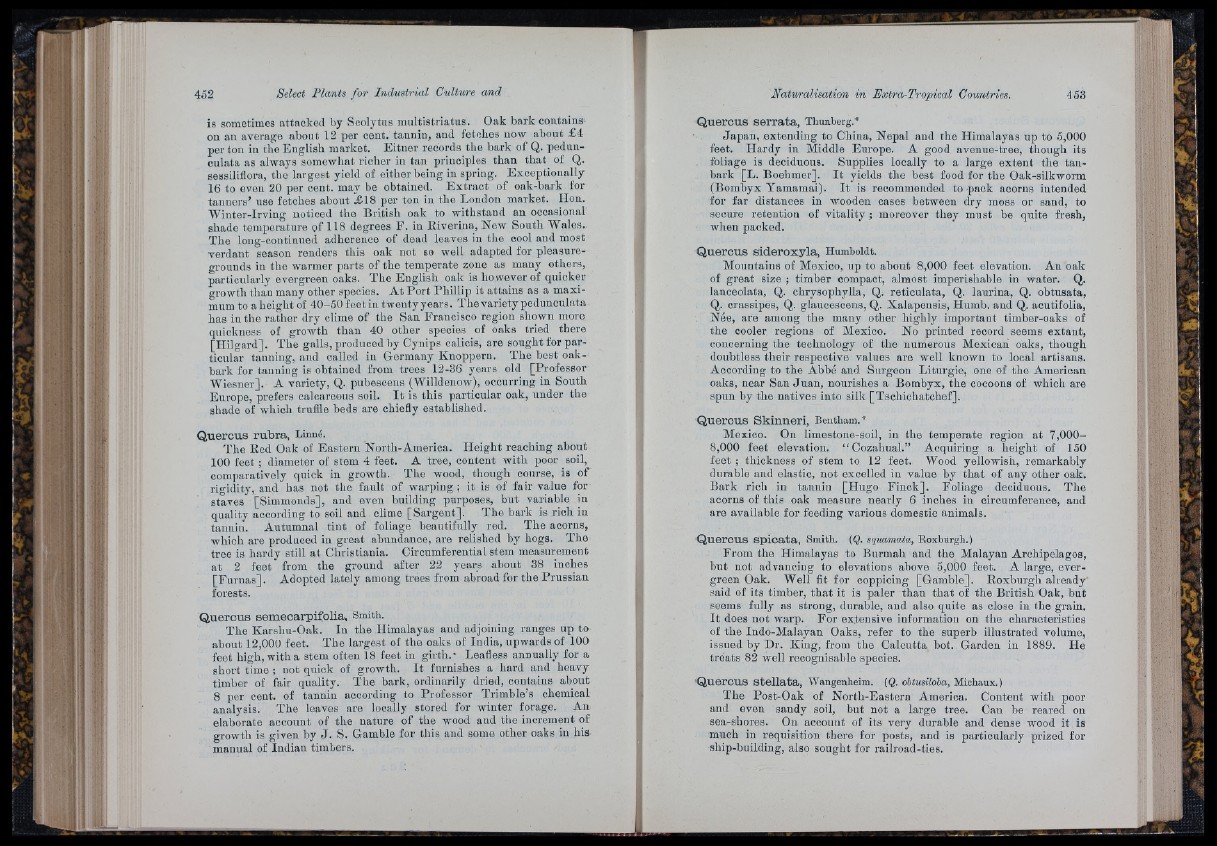
l ï .
i
is sometimes attacked by Scolytus multistriatus. Oak bark contains
on an average about 12 per cent, tannin, aud fetches now about £ 4
per ton in the English market. Eitner records the bark of Q. pedunculata
as always somowhat richer in tan principles than th a t of Q.
sessiliflora, tho largest yield of either being in spring. Exceptionally
16 to even 20 per cent, may be obtained. E x tra c t of oak-bark for
tanners’ use fetches about £ 1 8 per ton in the London market. Hon.
Winter-Irving noticed the British oak to withstand an occasional
shade temperature of U 8 degrees F. iu Riverina, New South Wales.
The long-continned adherence of dead leaves in the cool and most
verdant season renders this oak not bo well adapted for pleasure-
grounds in the warmer parts of tho temperate zone as many others,
particularly evergreen oaks. The English oak is however of quicker
growth than many other species. A t I’ort Phillip it attains as a maximum
to a lieight of 40-50 feet in twenty years. The variety pedunculata
has in the rather dry clime of the San Francisco region shown more
quickness of growth tlian 40 other species of oaks tried there
[H ilg a rd ]. The galls, produced by Cynips calicis, are sought for particular
tanning, and called in Germany Knoppern. The best oak-
bark for tanning is obtained from trees 12-36 years old [Professor
Wiesner]. A variety, Q. pubescens (Willdenow), occurring in South
Europe, prefers calcareous soil. I t is this particular oak, under the
shade of which truffle beds are chiefly established.
Quercus rubra, Linné.
The Red Oak of Eastern North-Amerioa. Height reaching abont
100 feet ; diameter of stem 4 feet. A tree, content with poor soil,
comparatively quick in growth. The wood, though course, is of
rigidity, and has not the fault of warping ; it is of fair value for
staves [Simmonds], and even building purposes, but variable in
quality according to soil and clime [Sargent]. The bark is rich iu
taimiii. Autumnal tint of foliage beautifully red. The acorns,
which are produced in great abundance, are relished by hogs. The
tree is hardy still a t Christiania. Circumferential stem measurement
at 2 feet from the ground after 22 years about 38 inches
[F u rn a s]. Adopted lately among trees from abroad for the Prussian
forests.
Quercus semecarpifolia. Smith.
The Karshu-Oak. In the Himalayas and adjoining ranges up to
about 12,00U feet. The largest of the oaks of India, upwards of 100
feet high, with a stem often 18 feet in g irth .' Leafless annually for a
short time ; not quick of growth. I t furnishes a hard and heavy
timber of fair quality. The bark, ordinarily dried, contains about
8 per cent, of tannin according to Professor Trimble’s chemical
analysis. The leaves are locally stored for winter forage. An
elaborate account of the nature of the wood and the increment of
growth is given by J . S. Gamble for this aud some other oaks in his
manual of Indian timbers.
Naturalisation in Extra-Tropical Countries. 453
Quercus serrata, Thunberg.*
Japan, extending to China, Nepal and the Himalayas up to 6,000
feet. Hardy in Middle Europe. A good avenue-tree, though its
foliage is deciduous. Supplies locally to a large extent the tan-
bark [L. Boehmer], I t yields the best food for the Oak-silkworm
(Bombyx Yamamai). I t is recommended to pack acorus intended
for far distances in wooden cases between dry moss or sand, to
secure retention of vitality ; moreover they must be quite fresh,
when packed.
Quercus sideroxyla, Humboldt.
Mountains of Mexico, up to about 8,000 feet elevation. An oak
of great size ; timber compact, almost imperishable in water. Q.
lanceolata, Q. chrysophylla, Q. reticulata, Q. laurina, Q. obtusata,
Q. crassipes, Q. glauoeseens, Q. Xalapeusis, Humb. and Q. acutifolia,
Née, are among the many other highly important timber-oaks of
the cooler regions of Mexico. No printed record seems extant,
concerning the technology of the numerous Mexican oaks, though
doubtless their respective values are well known to local artisans.
According to the Abbo and Surgeon Liturgie, one of the American
oaks, near San Ju an , nourishes a Bombyx, the cocoons of which are
spun by the natives into silk [Tschichatchef].
Quercus Skinneri, Bentham.*
Mexico. On limestone-soil, in the temperate region a t 7,000-
8,000 feet elevation. “ Cozahual.” Acquiring a height of 150
feet ; thickness of stem to 12 feet. Wood yellowish, remarkably
durable and elastic, not excelled in value by th a t of any other oak.
Bark rich in tannin [Hugo Finck]. Foliage deciduous. The
acorns of this oak measure nearly 6 inches in circumference, and
are available for feeding various domestic animals.
Quercus spicata, Smith. (Q. squamata, Roxburgh.)
From the Himalayas to Burmah and the Malayan Archipelagos,
but not advancing to elevations above 5,000 feet. A large, evergreen
Oak. Well fit for coppicing [Gamble]. Roxburgh already
said of its timber, th a t it is paler than th a t of the Britisli Oak, but
seems fully as strong, durable, aud also quite as close in the grain.
I t does not warp. For extensive information on the characteristics
of the Indo-Malayan Oaks, refer to the superb illustrated volume,
issued by Dr. King, from the Calcutta hot. Garden in 1889. He
treats 82 well recognisable species.
Quercus stellata, Wangenheim. (Q. ohtusiloba, Michaux.)
The Post-Oak of North-Eastern America. Content with poor
and even sandy soil, but not a large tree. Can be reared on
sea-shores. Ou account of its very durable and dense wood it is
much in requisition there for posts, and is particularly prized for
ship-building, also sought for railroad-ties.